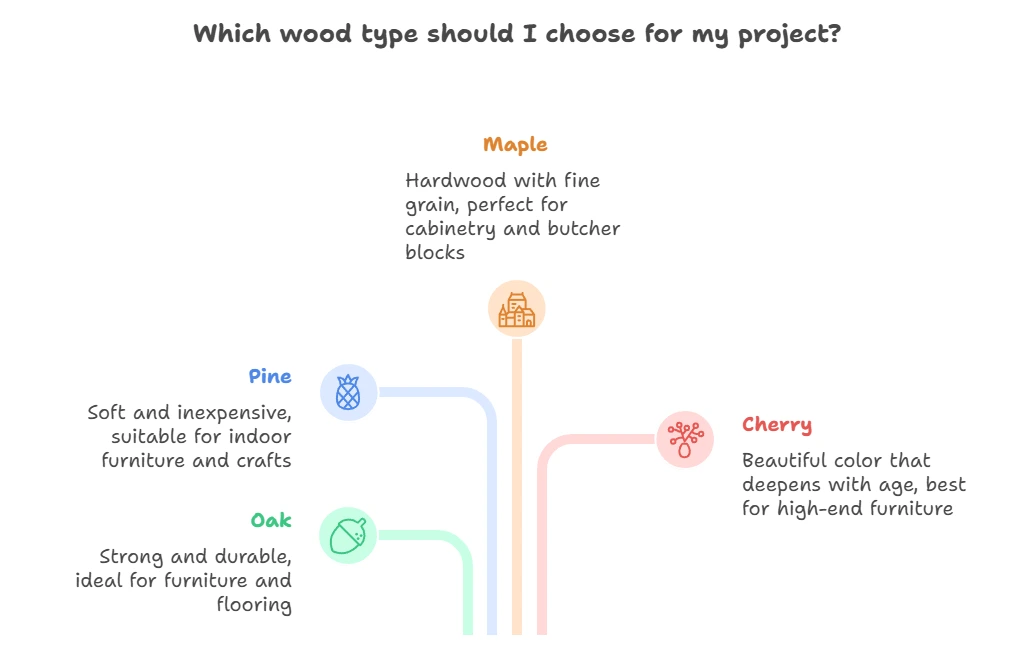
Creating beautiful and functional furniture involves careful planning and solid woodworking techniques. Effective furniture woodworking plans are critical for both beginners and seasoned carpenters. Here, we will explore the essential elements that make these plans truly effective, ensuring your projects are successful and enjoyable.
Clarity in Design
A well-defined design is the foundation of any successful furniture project. Your furniture woodworking plans should provide a clear visual representation of the final product. The following aspects ensure clarity:
- Detailed Diagrams: Use multiple views (top, side, front) to offer a complete perspective of the piece.
- Accurate Measurements: Clearly indicate dimensions to avoid errors during cutting and assembly.
- Material List: Provide a comprehensive list of materials, including type and quantity, to aid in proper planning.
Step-by-Step Instructions
Another vital element is the inclusion of step-by-step instructions. These should guide the woodworker through the construction process without ambiguity. A good woodworking plan might include:
- Sequential Steps: Number the steps in the order they should be completed.
- Tips and Tricks: Include helpful advice that may improve technique or simplify complex tasks.
- Visual Aids: Use images or diagrams alongside instructions to provide visual confirmation of each step.
Material and Tool Requirements
Understanding what materials and tools you’ll need is crucial for a successful completion. Incorporate the following in your plans:
- Specific Types of Wood: Recommend appropriate types of wood that suit the project, considering durability and aesthetics.
- Tool List: Outline the necessary tools, such as saws, drills, clamps, and more, making sure users have everything on hand.
- Safety Gear: Remind woodworkers to use safety equipment, such as goggles and gloves, throughout their projects.
Realistic Timeframes
Effective furniture woodworking plans should also include realistic estimates of how long each stage of the project may take. This helps in managing expectations and planning accordingly:
- Estimated Time: Provide a rough time estimate for each step to help woodworkers allocate their time efficiently.
- Buffer Time: Suggest setting aside extra time for unforeseen challenges, especially for beginners.
Problem-Solving Section
Anticipate challenges your readers may face and offer practical solutions. A dedicated section addressing common issues can significantly enhance the utility of your furniture woodworking plans. Consider including:
- Common Mistakes: Highlight errors often made during similar projects and how to avoid them.
- Troubleshooting Tips: Provide remedies for problems encountered during building, such as misalignments or material shortages.
Inspiration and Examples
Including inspiring ideas or examples of completed projects can motivate woodworkers. Showcase different styles and finishes that can be achieved with the same plan. This encourages creativity and personalization of each project.
Access to Resources
Your furniture woodworking plans should not exist in a vacuum; linking to additional resources enhances their value. Consider adding:
- Tutorial Videos: Links to video demonstrations can provide visual learning opportunities.
- Online Communities: Encourage readers to join forums or social media groups where they can share their projects and seek advice.
When developing furniture woodworking plans, consider drawing inspiration from reputable sites like Wood Magazine or Ana White. These resources offer expert advice, detailed plans, and a wealth of knowledge about woodworking.
By incorporating these essential elements, you can create woodworking plans that are not only effective but also enjoyable to follow. Remember that the ultimate goal is to empower others with the skills and knowledge to create beautiful furniture pieces that they can be proud of.
Choosing the Right Tools for Your Woodworking Projects
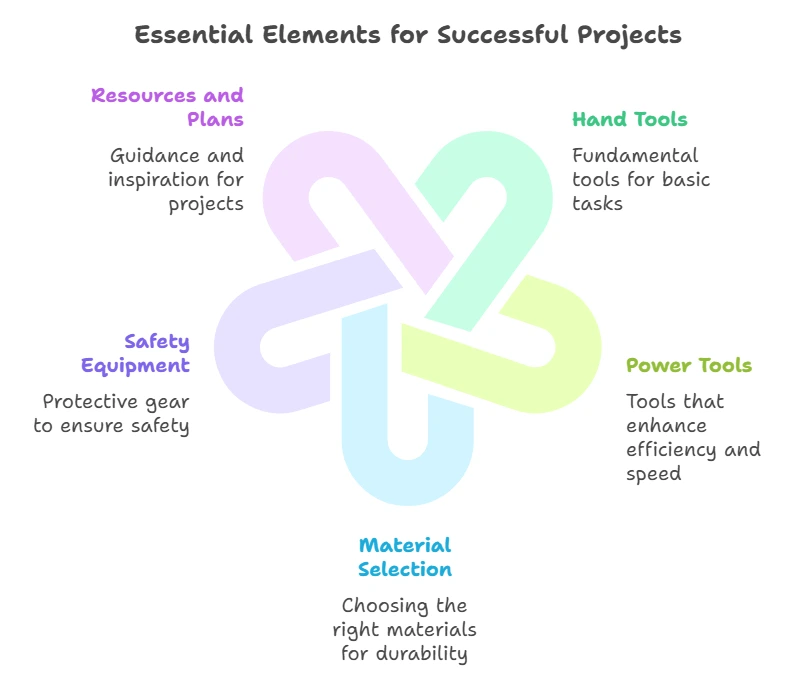
Building furniture or engaging in woodworking projects can be a fulfilling experience. However, the right tools can significantly impact your workflow, efficiency, and the quality of your finished product. When you have the correct tools at your disposal, you can tackle any woodworking project with confidence. Let’s explore some essential tools that can help you elevate your woodworking skills.
Essential Hand Tools
Hand tools are crucial for precision and control in woodworking. They are often favored by woodworkers for smaller projects and details.
- Chisels: These are perfect for making precise cuts and designs. A set of sharp chisels will help you carve joints and clean up edges.
- Saws: Familiarize yourself with different types of saws, such as hand saws, coping saws, and Japanese pull saws for various cutting needs.
- Hammers: A quality hammer is essential for driving nails or assembling joints. Look for one that feels comfortable and well-balanced in your hand.
- Measuring and marking tools: A tape measure, square, and marking gauge ensure accurate measurements and cuts.
Power Tools for Efficiency
Power tools speed up the woodworking process and can make complex tasks easier. Some popular options include:
- Table saw: This versatile tool is ideal for making straight cuts on larger sheets of wood. It can help you rip and crosscut with high precision.
- Router: Perfect for hollowing out areas in wood. A router is handy for shaping edges and adding decorative elements to your projects.
- Drill: An electric drill enables you to bore holes and drive screws efficiently, saving you time and effort.
- Sander: Sanding tools help smooth out surfaces, providing a finished look while removing rough edges.
Choosing the Right Material
Not all woodworking materials suit every project. Here is a quick guide on popular wood types:
| Wood Type | Characteristics | Best Uses |
|---|---|---|
| Oak | Strong, durable, and long-lasting | Furniture, cabinetry, flooring |
| Pine | Softwood, easy to work with and inexpensive | Indoor furniture, shelves, and crafts |
| Maple | Hardwood, with a fine, consistent grain | Cabinetry, butcher blocks, and flooring |
| Cherry | Beautiful color that deepens with age | High-end furniture, cabinetry, and musical instruments |
Safety Equipment
When working with sharp tools and heavy machinery, safety should always be your priority. Essential safety gear includes:
- Safety goggles: Protect your eyes from sawdust and flying debris.
- Hearing protection: Use earplugs or earmuffs when operating loud power tools.
- Dust mask: A mask can protect your lungs from fine wood particles.
- Work gloves: These provide a better grip and protect your hands from cuts.
Places to Find Plans and Resources
Once you have your tools, finding the right plans and resources can take your projects to the next level. Consider visiting websites that specialize in furniture woodworking plans:
- Wood Magazine – They offer various plans and tips tailored to different skill levels.
- Popular Woodworking – This site has unique designs and ideas for various woodworking projects.
- Ana White – Known for her free furniture woodworking plans, Ana White covers everything from furniture to decor.
Equipping yourself with the right tools and materials is crucial for any woodworking enthusiast. Prioritize safety, explore quality resources, and enjoy the satisfaction that comes from creating something with your own hands.
Common Mistakes to Avoid in Furniture Woodworking
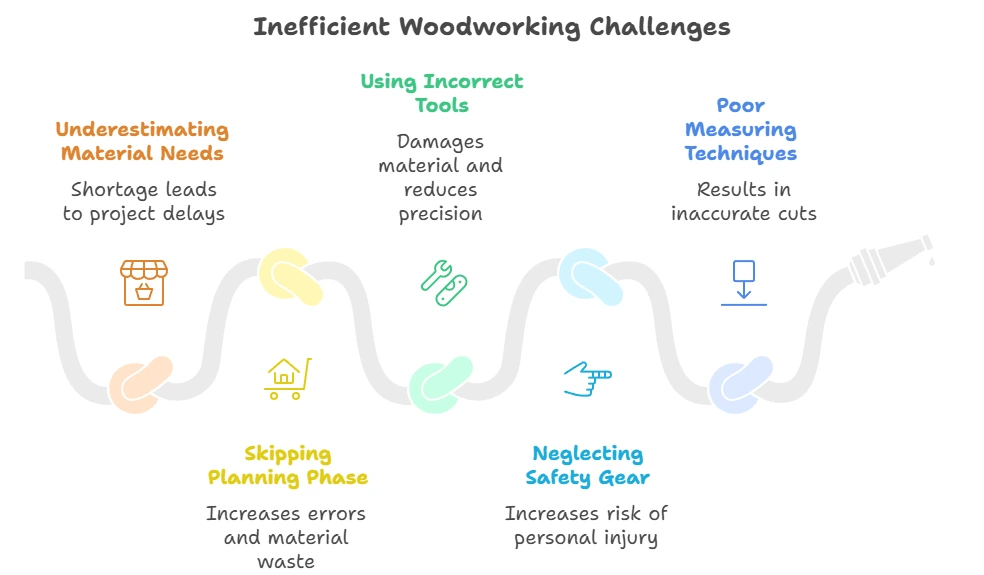
Woodworking is a beautiful craft that allows you to create stunning furniture pieces, but it’s easy to make mistakes if you’re not careful. If you’re diving into furniture woodworking, avoiding common pitfalls can save you time, money, and frustration. Here’s a look at some frequent errors and how to steer clear of them.
Underestimating Material Needs
One common mistake is misjudging the amount of wood and materials you need for a project. It’s tempting to buy just enough, but unforeseen issues often arise. Consider these tips:
- Always calculate the total square footage of your project.
- Add a safety margin of 10-15% to your initial estimate.
- Keep track of measurements in a dedicated notebook for clarity.
Skipping the Planning Phase
Jumping into woodworking without a solid plan can lead to costly errors. A detailed plan can help you avoid confusion and wasted materials. Here’s what you can do:
- Sketch your design on paper or use software tools for precision.
- Include specific dimensions and joints.
- Plan the assembly sequence to avoid assembly errors.
Using Incorrect Tools
Using the wrong tools can lead to poorly made furniture and safety hazards. Investing in quality tools is vital for successful woodworking projects. Consider the following:
- Always choose the right tool for the job—don’t improvise.
- Keep your tools well-maintained for better results.
- Invest in good-quality saws, drills, and measuring tools.
Neglecting Safety Gear
Your safety should always be a priority when woodworking. Many beginners overlook the importance of safety gear, which can lead to accidents. Ensure you:
- Wear safety goggles to protect your eyes from sawdust.
- Use ear protection if you are working with loud machinery.
- Wear gloves, but be cautious with them around powered tools.
Poor Measuring Techniques
Exact measurements are crucial when creating furniture. An error as slight as a fraction of an inch can throw off your entire project. To improve your measuring skills:
- Always measure twice, cut once.
- Use quality measuring tools like a tape measure or a square.
- Double-check measurements with a friend if needed.
Ignoring Wood Grain Direction
When cutting or sanding wood, it’s essential to pay attention to the grain direction. Ignoring this can result in splintering and damage. Here are some tips for handling wood grain:
- Identify the direction of the grain before making cuts.
- Sand in the direction of the grain to prevent scratching.
- Test cuts on scrap wood to see how the grain behaves.
Overlooking Finishing Techniques
Finishing your furniture properly enhances its appearance and durability. Many beginners rush through this stage, leading to uneven surfaces and poor protection. To perfect your finishing:
- Choose the right type of finish for the wood you are using.
- Apply multiple thin coats instead of one thick layer.
- Sand lightly between coats for a smoother finish.
Innovative Furniture Designs You Can Create at Home
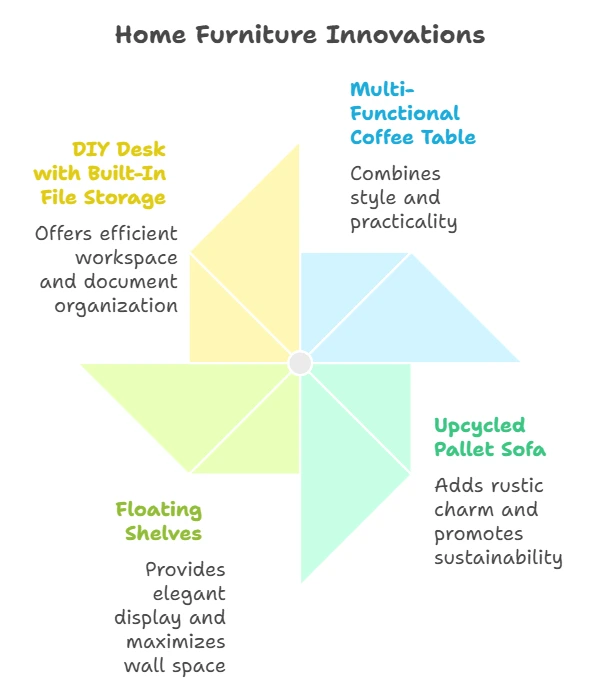
Creating innovative furniture designs at home is a rewarding endeavor that combines creativity, functionality, and craftsmanship. Whether you’re looking to refresh your living space, save money, or simply enjoy some hands-on work, making your own furniture can be the perfect project. Here are several exciting ideas and steps to inspire your next furniture-building adventure.
1. Multi-Functional Coffee Table
A multi-functional coffee table serves both style and utility. Consider creating a table that incorporates storage space beneath its surface. This can be achieved by using a simple design with a large top and a lower shelf or drawers.
Materials Needed
- Wood boards for the table top and legs
- Drawer slides, if you opt for drawers
- Wood screws and wood glue
- Sandpaper and finish (paint, wood stain, or varnish)
Steps to Create
- Design the table layout on paper, considering dimensions and storage options.
- Cut your wood to size based on your design.
- Assemble the main structure, ensuring stability with screws and glue.
- Add optional features, such as drawers or shelving.
- Finish off with sanding and apply your chosen finish.
For more detailed plans and inspiration, check out Popular Woodworking.
2. Upcycled Pallet Sofa
Using wooden pallets to create a sofa is a trendy way to produce chic outdoor or indoor seating. This idea promotes sustainability by repurposing materials that would otherwise go to waste.
Requirements
- 2-3 sturdy wooden pallets
- Cushions or foam padding
- Wood screws
- Sandpaper and weather-resistant wood finish (if used outdoors)
Step-by-Step Instructions
- Select pallets that are in good condition and free of splinters.
- Stack pallets to your desired height and secure them together with screws.
- Sand down rough edges to enhance safety and aesthetics.
- Add cushions or a mattress pad for comfort.
- Stain or paint the pallets to fit your décor.
For further tips on upcycling furniture, visit Upcycle That.
3. Floating Shelves
Floating shelves are a great way to display books, plants, or decorative items while saving floor space. They are relatively easy to install and can be a stylish addition to any room.
Material List
- Wood boards (choose your preferred type)
- Brackets (invisible brackets are preferred for a sleek look)
- Drill and screws
- Level tool to ensure proper alignment
Building Process
- Decide on the size and amount of shelves you want.
- Cut the wood to your desired dimensions.
- Install brackets on the wall using a drill and screws.
- Attach the wooden shelves to the brackets.
- Use a level to ensure everything is straight.
For guidance on wall mounting, check out Family Handyman.
4. DIY Desk with Built-In File Storage
Creating a desk that combines style and organization can enhance your productivity. A desk with built-in file storage keeps your workspace tidy.
Required Supplies
- Wood planks for the top and side panels
- Hardware for filing cabinets or cubbies
- Wood screws and glue
- Sandpaper and finish
Creating Your Desk
- Sketch out a design that includes drawer dimensions for file storage.
- Cut the wood to create the frame and surface.
- Assemble the structure and install the drawers or cabinets.
- Smooth the surface with sandpaper before painting or staining.
The Benefits of Using Digital Software for Woodworking Plans
In woodworking, having a solid plan is essential for crafting stunning furniture. With the rise of technology, digital software has emerged as a valuable tool for both novice and experienced woodworkers. Here are several benefits of adopting digital software for furniture woodworking plans, allowing you to achieve precise and efficient results.
Enhanced Precision and Accuracy
Digital furniture woodworking plans offer a level of precision that traditional methods cannot match. Using computer-aided design (CAD) software, you can create detailed blueprints that outline every dimension and angle. This precision minimizes errors that can occur when measuring by hand, ensuring that the pieces fit together seamlessly. Moreover, these digital tools allow you to adjust measurements effortlessly, making it easy to accommodate different furniture styles and sizes.
Customizable Designs
One of the standout features of digital furniture woodworking plans is their customizability. You can easily modify existing templates to fit your specific needs or preferences. Whether you want to change the dimensions of a table or add intricate details to a chair design, digital software enables you to experiment without the risk of wasting materials. This flexibility promotes creativity and innovation in your woodworking projects.
Access to a Wide Range of Resources
When you utilize digital software, you gain access to a treasure trove of resources. Many platforms offer pre-made plans, 3D models, and tutorials that can enhance your woodworking knowledge. Websites like Wood Magazine and Woodworking Tips provide excellent digital content, allowing you to learn new techniques and styles while working on your projects. You can also find forums and communities where fellow woodworkers share insights and inspiration.
Time Efficiency
Time is a crucial factor in any woodworking project. Digital software can significantly speed up the planning process. Instead of spending hours drafting plans manually, you can quickly input specifications into a digital tool. The software can generate a cutting list and project timeline, allowing you to focus on the actual construction. This efficiency is particularly beneficial for those who work on multiple projects or have tight deadlines.
3D Visualization
Another compelling advantage of digital furniture woodworking plans is the ability to visualize your project in 3D. Many digital design tools offer rendering capabilities, allowing you to see what your finished piece will look like before you start cutting wood. This visualization can be incredibly helpful in making design choices and ensuring that the final product meets your expectations.
Integration with CNC Machines
Digital furniture woodworking plans can also be integrated with CNC (Computer Numerical Control) machines. These machines can automate the cutting process based on the precise specifications from your digital designs. This integration not only saves time but also enhances accuracy, making complex cuts easier to execute. For woodworkers looking to elevate their craftsmanship, embracing CNC technology can take your projects to the next level.
Cost-Effective Solutions
Investing in a digital furniture woodworking plan often proves to be cost-effective in the long run. By minimizing material waste and reducing mistakes, you save money on supplies. Moreover, many software options have affordable subscriptions or one-time purchase fees, making them accessible for most woodworkers. The money saved on materials and the time gained from efficiency make digital tools a worthwhile investment.
Collaboration and Sharing
Digital software allows for easy sharing and collaboration among woodworkers. You can send your designs to friends or mentors for feedback, making the woodworking community more interconnected. Platforms like Woodworker’s Source provide community features where you can showcase your digital plans and receive constructive criticism, leading to improved skills and innovative ideas.
| Benefits of Digital Woodworking Plans | Description |
|---|---|
| Enhanced Precision | Minimizes errors with accurate measurements. |
| Customizable Designs | Modify templates easily for unique creations. |
| Resource Access | Gain from a variety of plans, tutorials, and communities. |
| Time Efficiency | Streamline the planning process with quick input. |
| 3D Visualization | Preview your project in 3D for better design decisions. |
| CNC Integration | Automate cuts with digital designs for complex shapes. |
| Cost Efficiency | Reduce waste and save money on materials. |
| Collaboration | Easily share designs for feedback and improvements. |
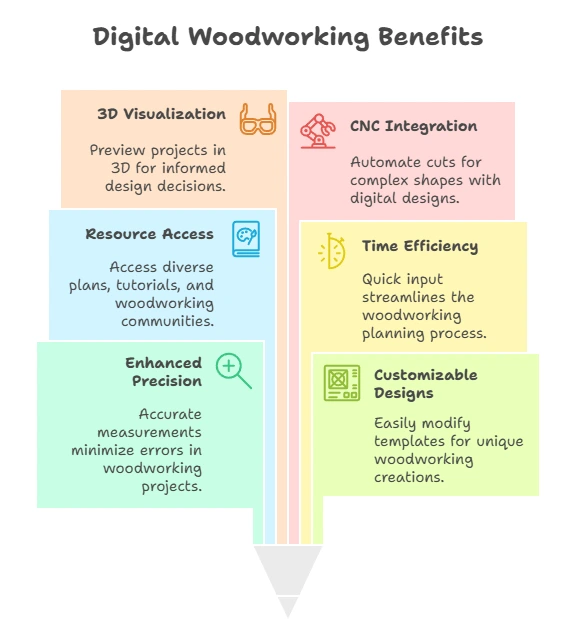
As you explore the world of furniture woodworking plans, consider incorporating digital software into your toolkit. The advantages are clear—whether it’s saving time, enhancing precision, or fostering creativity, digital tools can elevate your woodworking experience and help you craft beautiful, well-planned furniture.
Conclusion
Effective furniture woodworking plans serve as a cornerstone for successful projects, guiding both beginners and experienced woodworkers. By understanding essential elements—such as detailed measurements, material specifications, and step-by-step instructions—you can simplify your building process and enhance the quality of your creations. Choosing the right tools is equally crucial; investing in quality equipment not only streamlines your work but also elevates your craftsmanship.
Avoiding common mistakes, like miscalculating dimensions or overlooking proper joinery techniques, can save you time and frustration. Awareness of these pitfalls will lead to smoother projects and more satisfying results. Furthermore, exploring innovative furniture designs allows you to personalize your space and add unique touches to your home. Whether it’s a modern coffee table or rustic shelves, creativity knows no bounds with the right plans.
Incorporating digital software into your woodworking arsenal can further sharpen your skills. These tools empower you to visualize designs, execute precise measurements, and even adjust plans quickly, making the woodworking experience more enjoyable and efficient. Embracing technology alongside traditional methods opens up a world of possibilities.
By focusing on these aspects, you empower yourself to tackle furniture woodworking plans projects with confidence and creativity. Armed with comprehensive plans, the right tools, and an understanding of common pitfalls, you can confidently embark on your woodworking journey and create stunning pieces that reflect your style. Happy woodworking!
